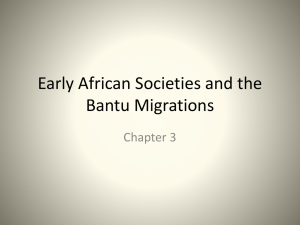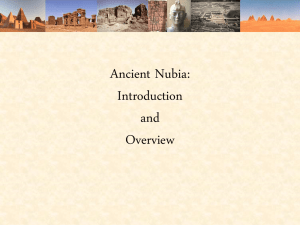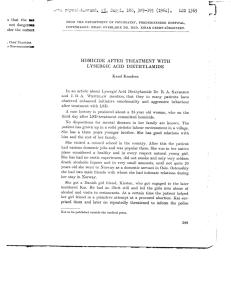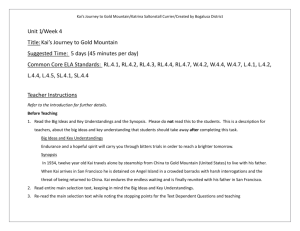to learn more... - Charles H. Wright Museum of African American
advertisement
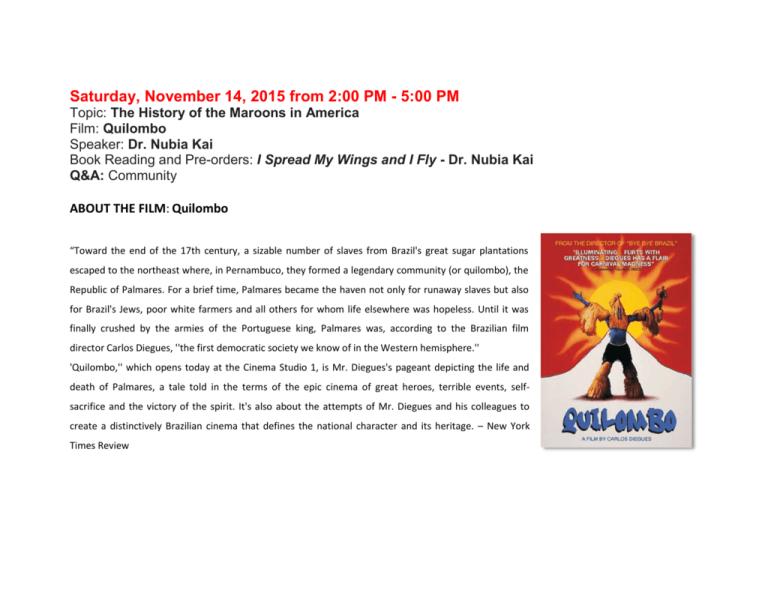
Saturday, November 14, 2015 from 2:00 PM - 5:00 PM Topic: The History of the Maroons in America Film: Quilombo Speaker: Dr. Nubia Kai Book Reading and Pre-orders: I Spread My Wings and I Fly - Dr. Nubia Kai Q&A: Community ABOUT THE FILM: Quilombo “Toward the end of the 17th century, a sizable number of slaves from Brazil's great sugar plantations escaped to the northeast where, in Pernambuco, they formed a legendary community (or quilombo), the Republic of Palmares. For a brief time, Palmares became the haven not only for runaway slaves but also for Brazil's Jews, poor white farmers and all others for whom life elsewhere was hopeless. Until it was finally crushed by the armies of the Portuguese king, Palmares was, according to the Brazilian film director Carlos Diegues, ''the first democratic society we know of in the Western hemisphere.'' 'Quilombo,'' which opens today at the Cinema Studio 1, is Mr. Diegues's pageant depicting the life and death of Palmares, a tale told in the terms of the epic cinema of great heroes, terrible events, selfsacrifice and the victory of the spirit. It's also about the attempts of Mr. Diegues and his colleagues to create a distinctively Brazilian cinema that defines the national character and its heritage. – New York Times Review About the Speaker Nubia Kai (a.k.a. Nubia Kai Al-Nura Salaam) received a B.A. degree from Wayne State University in Anthropology and Black Studies, a M.A. degree from the University of Wisconsin in African Languages and Literature, and a Ph.D. in African Literature and Film at Howard University. A poet, playwright, storyteller, and novelist, Ms. Kai has won numerous awards for her writing, including three Michigan Council for the Arts Awards, three D.C. Commission on the Arts Awards, two National Endowment for the Arts Awards, and the Larry Neal Writer’s Competition for Poetry. She has been published in Black Scholar, Black World, Essence Magazine, Black American Literature Forum, Quilt, Catalyst, Solid Ground, City Arts Quarterly, Obsidian, Black Books Bulletin, Moving Out, Journal of Black Poetry, Left Curve, Journal of African Literature Association, Black Camera, Journal of African American History and several other journals and anthologies. She has published two collections of poetry, Peace of My Mind and Solos, a collection of short stories, The Sweetest Berry on the Bush, and a scholarly text Kuma Malinke Historiography: Sundiata Keita to Almamy Samori Toure. Her plays have been produced at the New Federal Theater, Penumbra Theater, ETA Theater, and Tafari Jirani Theater. She has taught in the History Department at George Washington University and was an assistant professor at Howard University’s Department of Theatre Arts and an adjunct professor at University of Maryland-Baltimore’s Africana Studies Department. 2 About the Book SYNOPSIS: I SPREAD MY WINGS AND I FLY I Spread My Wings And I Fly is an historical novel set in the mid 1850’s in southern Louisiana. The novel focuses on the maroon tradition in the United States, the psychological effects of slavery, and the dynamics of slave culture, folklore, and philosophy. Based on historical documentation, folklore, myths, songs, slave narratives, and ethnographic studies, the novel attempts to illustrate through the epic narrative form the rich, varied, and highly philosophical and metaphysical culture of the slaves, their militancy, self-expression, and quest for freedom. My objective is to reveal the long suppressed historical facts of the role of voodoo and maroon guerrilla warfare in paving the road to Emancipation. In this way the novel will continue and expand the tradition set by authors of great slave literature such as, The Slave Narrative of Gustavus Vassa, The Narrative of the Life of Frederick Douglass, Uncle Tom’s Cabin, Jubilee, Roots, Dessa Rose, The Known World, etc. by exposing a dimension of the American slave experience that had previously been unexplored. 3 During the mid-nineteenth century when the slave narratives were popular, the authors of the narratives, for political reasons, were not able to expound on the practice of armed resistance against slavery; nor did they recognize the role of voodoo in slave resistance. There are several texts that deal with maroon communities in Jamaica, Guyana, Brazil and Surinam, but with the exception of Gwendolyn Midlo Hall’s Africans in Colonial Louisiana, there are no literary or historical texts that focus on the maroon tradition in the United States. The novel opens in the year 1853 on L’amour, a 2,000 acre estate in southern Louisiana. The slaves are going to the sugarcane fields when Caleb, the son of a maroon and repeated runaway, gets into a fight with his cabin mate. An overseer attempts to whip Caleb but he fights back and flees the plantation. The novel follows Caleb in odyssey fashion through many trials, tribulations, and astounding events, all of which he somehow learns and grows from. He encounters the constant dangers of a fugitive in flight, a powerful juju (voodoo practitioner), a maroon camp, and a slave woman he falls in love with until he is captured and brought back to L’amour Plantation. By this time his love and pursuit of freedom is tenacious and undaunted. He plans with fellow slaves an escape to Oklahoma but is sold to a Greek ship captain and owner of a fleet of fishing schooners one week before the plan is to be executed. A year later Caleb finally makes plans with other slave shipmates to mutiny and escape to Northern Yucatan. The slaves successfully launch an attack against the whites on the ship and an old experienced African sailor steers the ship to Yucatan. The novel ends with the rebels charging the sands of Yucatan in victorious revelry, and Caleb recounting the story of his life in an allegorical tale. The esoteric meaning of the title, I Spread My Wings And I Fly (taken from the last stanza of the Negro Spiritual, Sometimes I Feel Like A Motherless Child), is revealed in this last scene. The slaves’ struggle for freedom is spiritually and allegorically linked to the soul’s struggle to unite with a higher being. 4 This book is dedicated to the maroons in America, in commemoration of their great dignity, beauty, wisdom, integrity, courage, strength and the powerful legacy they left behind to inspire us. Suggested Readings and Links http://lanic.utexas.edu/project/etext/llilas/ilassa/2007/canto.pdf http://www.sylvianediouf.com/slavery_s_exiles__the_story_of_the_american_maroons_119566.htm http://www.pbs.org/wgbh/aia/part2/2p50.html http://www.amazon.com/The-Maroon-Within-Community-Socialization/dp/0933121849 Kuma Malinke Historiography: Sundiata Keita to Almamy Samori Toure Sep 26, 2014 by Nubia Kai 5 Sweetest Berry on the Bush May 1, 1993 by Nubia Kai Solos Dec 1988 by Nubia Kai Parting (A Play) 1989 - by Nubia Kai Harvest the Frost (A Play) 2000 by Nubia Kai Paperback 6 The Last of the Reapers (A Play) 1991 by Nubia Kai Kuma Malinke Historiography: Sundiata Keita to Almamy Samori Toure by Kai, Nubia (2014) Hardcover I Spread My Wing and Fly 7




